Oolong teas - Fujian rarities
Fuzhou, 7th May 2016
Modern, old, and modern again.
Yesterday afternoon I took a high-speed train from Hangzhou to Fuzhou. Just few hours to cover more 700 kilometers. The Chinese high-speed railway is the most modern I have seen and its network grows incredibly fast, year after year. Last spring it took a whole night to travel from Wuyishan (where the Wuyi Rock teas are produced) to Shanghai; since the beginning of 2016 only two and half hours are needed!
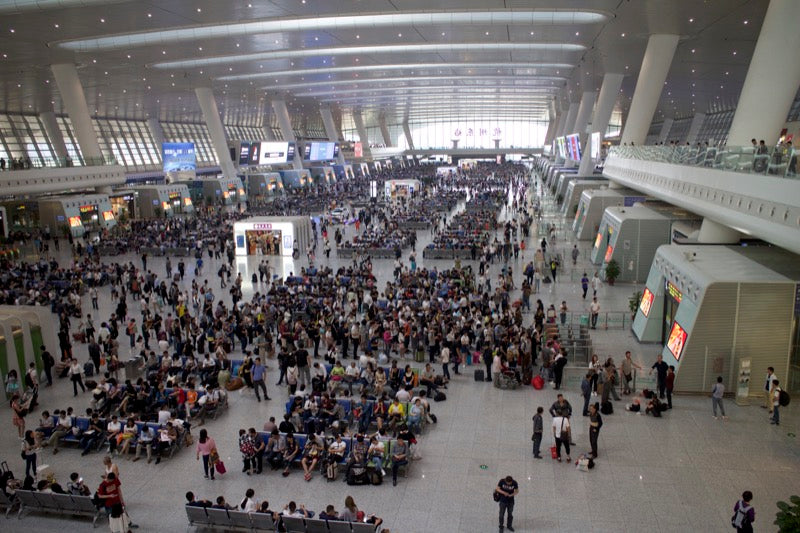
Hangzhou high-speed railway station.
I spend the night in the same hotel where I stayed last year; simple, cheap and clean… at least that is what I thought before spotting a huge brown cockroach next to my bed and its companion, as big as my thumb, in the shower.
In the morning, Ms. Yang Wei picks me up in her brand-new, white BMW. She is a friend of a friend of a friend; for to me unknown reasons she is willing to help me. Ms. Yang is very elegant: hair tied back, hairband with bow, and refined bearing. She is very quiet, apparently serious. But her sporadic hearty laughs reveal a lighthearted soul.
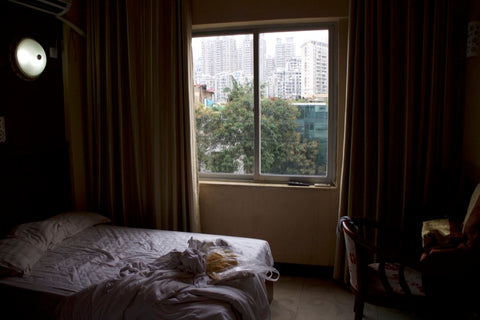

Hotel room. Ms. Yang behind the wheel of her fancy BMW.
Ms. Yang is not in the tea business. She worked for long time in trading and now, to have more time for her son, manages a publishing house instead. In China, business and personal affairs are based on friendships and relationships. And Ms. Yang seems to have collected quite a few of them during her life. Just two days ago I told her which teas I am searching for; within a day she organised my stay in Fuzhou.
I have no time to travel to South Fujian, where Bai Ya Qi Lan and Zhang Ping Shui Xian are produced. Both are fairly unknown oolong teas that just now are gaining popularity in China. In my opinion, both are superior to the well-known and over-priced Tieguanyin. In Fuzhou, the capital of the Fujian province, is easy to find Tieguanyin, Wuyi Rock tea and the black teas from northern Fujian. But I never discovered shops selling the two oolongs mentioned above. Moreover, I am seeking organic tea, which makes the search even more complex.
We drive to a tiny but beautiful teashop where we will spend the whole day. The owner, a former interior designer, decided two years ago to change career and opened this teashop.
On the gongfu cha table there is a terracotta pot. Inside, leaves of white tea are steeping in boiling water; a new way of brewing tea that I had seen only with Pu’er.

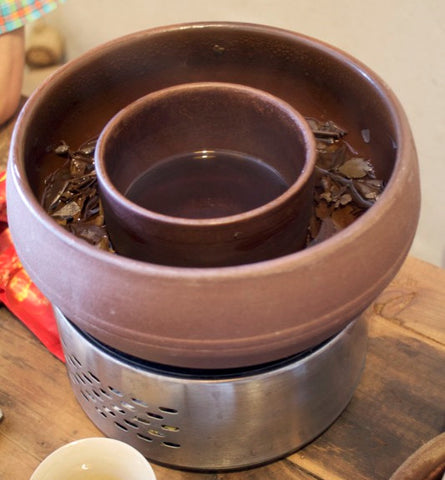
On the left: Teashop in Fuzhou, where Ms. Yang organized today’s tea meetings.
On the right: A terracotta pot on an electric stove. Boiling water with few leaves of white tea (Bai Mu Dan). From time to time some tea is taken out of the pot and served while the rest continues boiling.
Whilst waiting for the tea farmers, we drink boiled white tea, an outstanding Shuixian Rock tea (unfortunately too expensive for Nannuoshan; I can buy just 50g for me). During the tasting, Ms. Yang shows some pieces of her jade collection. She selects the minerals, design the pendants and commission carving to specialised workshops.


An old jar is used as disposal on the gongfu cha table. Two pieces of Ms. Yang’s jade collection.
Showing off is embedded in Chinese culture, as well as believing any bullshit they are been told. Modesty, embarrassment, and a sense of proportion are unknown concepts. Every second day a tea seller shows me his collection of cups from the 'Ming' and 'Song' dynasties; which actually are only found in museums. Others have to steep their 70-year-old pu’er which, most likely, are much, much younger. Another must tell me how much he spent (thousands of Euro) for a tea tray or introduce me to his friend pretending he is the best producer of a certain tea, the most renewed tea taster of whole Fujian and so on... every day new incredible stories to listen and repeat to others.
Today's incredible story is the jade collection of Ms. Yang. She would like to open a show room in town. "Are all those jades real?" I ask myself.
Luckily, the first tea farmer enters the room; there is no more reason to entertain me with incredible stories. He produces Zhang Ping Shui Xian, an oolong tea from South Fujian packed in tiny single-use bricks.
He drove for three hours this morning just to meet me and will drive back home tonight, taking a whole day off in the busy tea season. While the production of green tea is already over, the larger leaves required for oolong teas are being picked right now.
I like him. He seems sincere and does not show off. He owns photos of his tea gardens. He processes the leaves himself, having full control over the whole process from cultivation to final product. He shows several videos and photos and answers my questions briefly but precisely. The tea is excellent! A fresh green Oolong with no sign of astringency; mouth-filling and smooth. The floral taste is upfront, neither too sweet, nor too sharp.
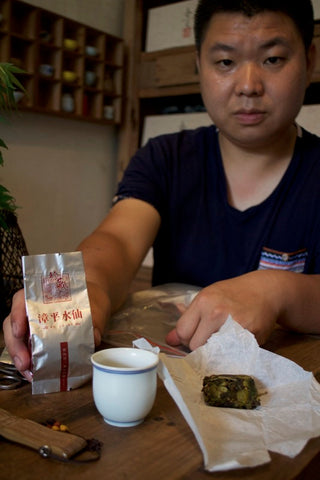
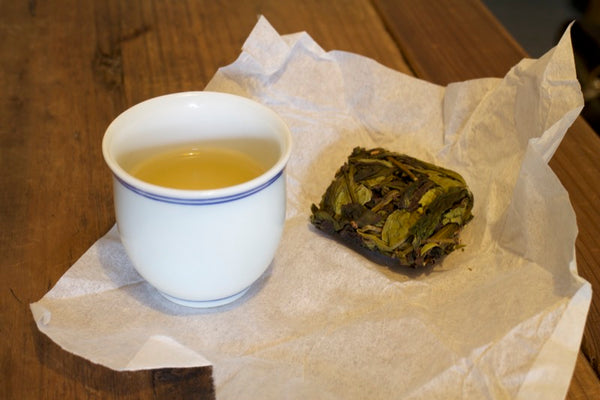
Tea farmer proudly showing his Zhang Ping Shui Xian, a relatively unknown oolong tea from south Fujian.
In the meanwhile, other tea producers and friends arrive. The little shop is crowded. Time to go for lunch… seafood!
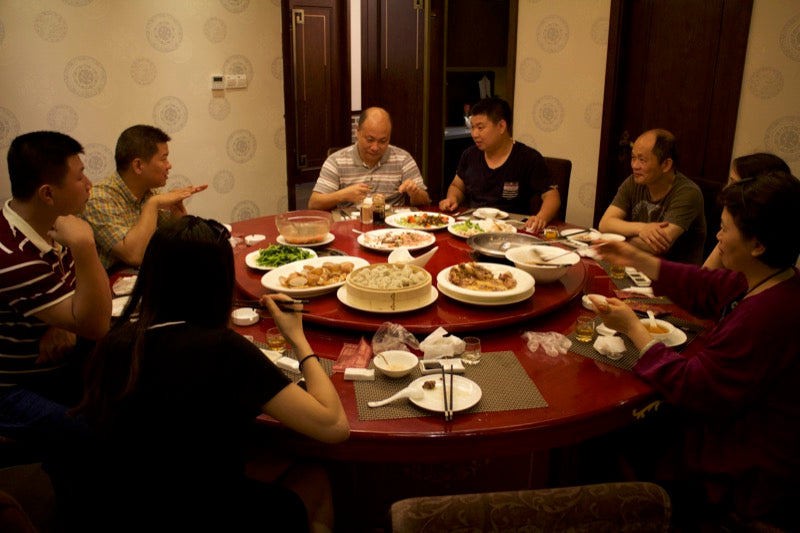
Lunch with Ms. Yang, my interpreter, and a bunch of tea producers.
In the afternoon is the time for Bai Ya Qi Lan, an oolong tea invented in 1982. The owner and the manager of a medium size tea factory came over to Fuzhou with many tea samples.
We start with a Mao Cha (half-processed tea) picked just yesterday. Then we taste a roasted Bai Ya Qi Lan to appreciate the influence of roasting on the leaves. Fuller and stronger than the Mao Cha, but still very aromatic; less sweet, but not at all bitter. For my interpreter, the Mao Cha was even too sweet! She prefers the heavily roasted Rock Teas from Wuyishan.
The next tea is Jin Mu Dan (Golden Peony). A tea recently developed by crossing two tea plants, Tieguanyin and Huang Dan. Clear scent of orchid, a strong presence in the mouth, lingering, delightful.

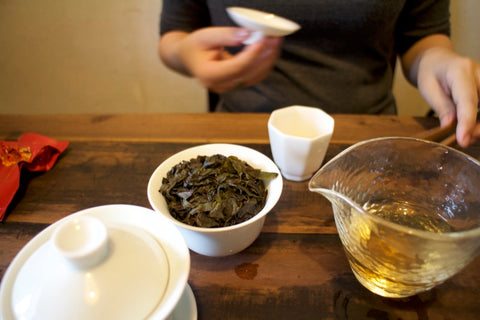
Leaves of Bai Ya Qi Lan before and after steeping. A rolled oolong tea similar in appearance to Tieguanyin, but sweeter and less astringent.
They also produce a scented tea in a similar fashion as jasmine tea, but using pomelo flowers instead. The flowers are mixed with the tea leaves to give them their fragrance and removed before packing. Unfortunately they have no sample of You Xiang Qi Lan (You Zi means Pomelo, Xiang means fragrance). They will send me samples to Shanghai, together with more samples of Bai Ya Qi Lan and Jin Mu Dan.
In January, during my last tea journey, I had already purchased a Bai Ya Qi Lan. I will compare it with the one just discovered upon my return in Berlin and for now buy only the Jin Mu Dan and, if convincing, the You Xiang Qi Lan.
Written by Gabriele





